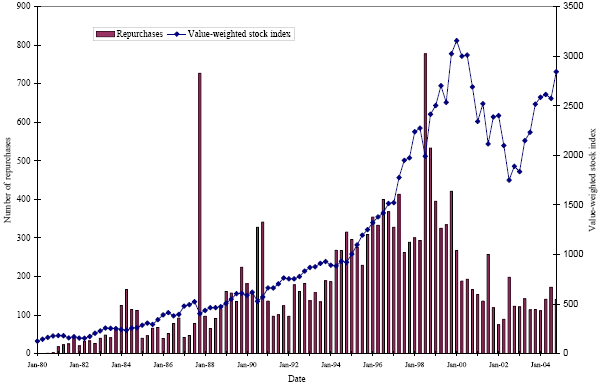Does the business cycle beget a stock supply cycle? In their January 2007 paper entitled “Corporate Event Waves”, Raghavendra Rau and Aris Stouraitis examine the relationships among five different kinds of stock supply additions and subtractions: initial public offerings (IPO); seasoned equity offerings (SEO); stock-financed acquisitions; cash-financed acquisitions; and, stock repurchases. Using data for 151,000 U.S. corporate stock supply transactions during the period 1980-2004, they conclude that:
- The stock supply cycle starts with a wave of new issues (with SEOs preceding IPOs), followed by a merger/acquisition wave (stock-financed and cash-financed together), followed by a share repurchase wave.
- Evidence of this pattern holds in many, but not all, industry segments.
- Results suggest that stock supply cycles begin with strong fundamentals, and both managers and investors become excessively optimistic and overreact to these fundamentals.
The following chart, taken from the paper, relates aggregate U.S. stock market price level (a value-weighted NYSE/AMEX/Nasdaq index) and share repurchase activity (number of transactions) for a sample of 17,342 repurchases during 1980-2004. It appears that buyback activity generally grows with the market through the 1990s, perhaps spiking after sharp downturns. In the early 2000s, buyback activity and stock prices decline together. Results appear to indicate that firm executives are not especially good timers of the aggregate stock market. [Detrending of the two series and use of log scales might facilitate further investigation.]

In summary, there is a cycle of cash flow between companies and investors, as the former first sell shares, then buys the shares of other companies and finally buys back their own shares.
While the proposition is plausible and interesting, it seems doubtful that 25 years is enough history for reliable inference regarding the regularity of a multi-year series (not enough cycles). The finding here that executives do not effectively time SEOs and buybacks is somewhat at odds with other research, perhaps because of longer measurement horizons or cross-currents between aggregate market behavior and individual company behaviors.